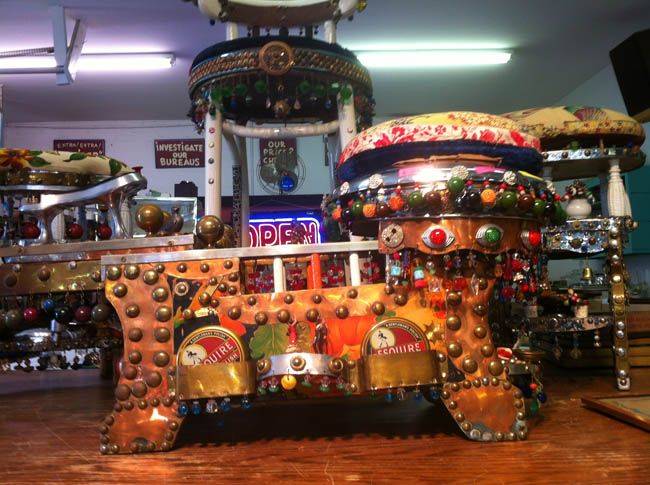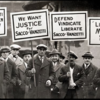Giovanni Indelicato, Bootblack Artist, Rediscovered and Reclaimed
The phone call came in at 12:10pm on Friday, May 9th. I wasn’t at my desk and so the reception for the Calandra Institute took a message. It was not until 4:00 that I saw the written message when I just happened to check my snail mail inbox. I was leaving the office early because I was driving the next morning at 5:30am to Galloway, New Jersey to attend the Vernacular Architecture Forum’s annual conference. The message read:
From: Lynne Atkins of auction house in Jersey Shore Message: Re: An article you wrote on Joe Milone. The Auction house is selling items regarding his work tomorrow. Please call, would love to speak with you.
The “article” was my 2008 blog post “An Epic of Mediterranean Culture” about a Sicilian immigrant bootblack whose decorated kit was discovered by artist Louise Nevelson and eventually displayed in the Museum of Modern Art in 1942. Towards the end of my blog I wrote, “It is presumed lost.”
Could it be? Had it been found? And if so, it was to be auctioned the very next day. I called Lynne back immediately.
Lynne, along with her husband Herb Atkins, is the owner of Concepts 1 Auction House in Point Pleasant. She told me Milone’s granddaughter had the presumed lost work of Italian-American vernacular artistry and that it was brought in for auction by her husband. I was overwhelmed with excitement.

Lynne directed me to the auction house’s web page where I saw small images of the work. There it was, found. Lynne told me that auction would begin at 12:30 the next day. I told her I would be there. Galloway was an hour drive north to Point Pleasant.
The first thing I did was to call Paul D’Ambrosio, president and Chief Executive Officer of the Fennimore Art Museum in Cooperstown, New York. Paul is a colleague who has done definitive work on painter Ralph Fasanella and with whom I worked with on the donation of a piece by the late folk artist Vincenzo Ancona. He was driving to Boston. Thankfully his secretary gave me his cell phone number and I left an animated message.
That night as I was preparing to go to sleep, the artist’s granddaughter Cherylann Indelicato emailed me.
Dear Dr. Sciorra,
While googling my grandfather’s name and shoe shine stand, I came across your 2008 article in the I-Italy blog regarding Mediterranean Culture, where you discussed at length the story of Joe Milone a presser from Sicily who had created a work of art with the world's most beautiful shoe shine stand. Louise Nevelson discovered my grandfather's masterpiece, and it was exhibited at MOMA and at the World’s Fair.
Towards the end of the article you mentioned that this beautiful shoe shine stand represented many things, and that it is probably lost. I thought you might be interested to know that I still have all of the pieces of this beautiful shoe shine stand that my grandfather created. I have saved it as a memento of my heritage, and always wondered if I should share it again with the world! I have also saved all the articles written about this truly remarkable piece, and would be happy to share them with you.
Thank you for recognizing my grandfather and his labor of love.
Cheri Indelicato
A month after the auction I met with Cherylann and her husband Alesso Accomando in their Point Pleasant home and they told me how the pieces came to be auctioned:
For years the pieces were stored in sealed boxes in the garage, with her father Accurso’s handwriting. Cherylann had once called the auction house Sotheby’s who expressed no interest in the work. She had gone around to auction houses in town but no one was interested. In a move to clean the garage she told her husband, “Do what you want with it.”Alessio, who had not seen the contents of the boxes, decided to put it all on the curb as garbage but when he pulled out one of the pieces from the box he realized that this was no ordinary shoeshine kit. He approached his neighbor and together they decided to take it to the flea market in town. There Pat O’Shea, who operates a table, suggested he bring it to Concepts 1 Auction House.
Encountering the Art Work
It seemed like the stars were aligned and Saturday was to be an auspicious day. I was fortunate because I was originally scheduled to be in Italy during this time but had cancelled the trip because of my workload. In addition, I was attending the conference but was not presenting or chairing a panel, which meant I could leave when I wanted. Upon arrival in Galloway, I gushed with exhilaration to colleagues telling them I had to forgo lunch together because I was attending the auction.
When I arrived in the one-story auction house, the day’s bidding was in full swing but I was announced as entered the building by the auctioneer Herb Atkins: “Here he is folks! He’s come down from New York for today’s auction, what everybody is waiting for. The shoeshine box! And it begins at 12:30!” I felt as if I was being treated like the Anthony Bourdain of folk art, a celebrity who was conferring cache on the piece to be auctioned.
And there it was, displayed on the table for all to see. I had only seen black and white photographs. There were seven pieces: shoeshine kit, the bootblack’s seat, the customer’s seat, other items that completed the set. They were highly decorated with brightly-colored plastic beads, brass studs, figurines, and fabric. It was stunning to behold.
The house was packed with what appeared to be exclusively local folks. No art collectors from the Big Apple or elsewhere.
I first met Lynn who in turn introduced me to Cherylann and Alessio. They showed me a scrapbook of the shoeshine kit’s display with newspapers articles, photographs, MoMa press releases, and a letter from Nevelson.

The items documented that the work was used in a department store window display and featured in a Harper’s magazine spread for the season’s new lines of shoes.

Cherylann lent me the book so I could scan it as they were leaving for Italy that Tuesday. And soon the auction began.
The bid opened at $5,000. No one moved. Then the bid was lowered to $4,000. No takers. $3,000. Silence. At $2,000 the bidding started and I was standing in at the center of the vortex of three bidding individuals. A middle-age man sitting in the audience to my left started and the bid was immediately taken up by a 30-something man standing just behind me. Soon the seated man dropped out. As the bid was closing, a woman in her 40s upped the bid, and it turns out it was Pat O’Shea. We had chatted briefly before the bidding started about the importance of the work and how belonged a museum. She stuck to her guns and won the work at $3,000. I told her I was in communication with a museum who was interested in the piece if she was interested in selling. I took down her contact info and I returned to my conference.
The next day I put Pat O’Shea and Paul D’Ambrosio in contact with one another, and they worked out a deal for the museum to buy the piece. Eve Kahn wrote about the purchase for the New York Times.
I am thrilled at having had a hand in locating a “lost” work of Italian-American vernacular art and securing its acquisition in a prestigious museum. Equally important was discovering the artist Giovanni Indelicato. So how did Giovanni Indelicato become Joe Milone?
Encountering the Artist
Cherylann, who was one-year-old when her paternal grandfather died, said that her father Accurso recounted that it was Louise Nevelson or someone at MoMa who decided that that the name Giovanni Indelicato was “too ethnic.” Why or how the name Joe Milone was suggested did not enter family memory. This erasure of the Italian-American artist from newspaper accounts of the day and the annals of American visual art is now poised to be undone with the rediscovery of his work. A combination of an interview with Cherylann and online searching using his artist’s real name we are able to reclaim Giovanni Indelicato for the history books.
Giovanni Indelicato was born December 13, 1887 in the Sicilian city of Sciacca. According to shipping manifests in the online archive at www.ellisisland.com there are two possibilities for his arrival date in New York City harbor: at 18-years-old in July 21, 1905 or 20-years-old on April 12, 1906. (Another Giovanni Indelicato arrived from Naples in 1910 at age 23. 1910 is the date for his immigration as stated in the 1930 census.) The information for both dates and individuals is similar in a number of ways:
The Indelicato who arrived in 1905 came with $12 and was going to stay his brother Martino Indelicato at 88 Watkins Street, Brooklyn. The Indelicato who arrived in 1906 came with $12 and was joining his uncle Calogero Bruno at 72 Glenmore Avenue, Brooklyn.
The curious thing is that 88 Watkins Street and 72 Glenmore Avenue are down the block from each other in the Brownsville neighborhood. Could this have been the same individual?
At some point Indelicato (who sometimes went by the Americanized name John) married Cira (listed as Cieida in the 1930 census) who was born in 1887 and said to have immigrated in 1915 (1930 census). She came from the town of San Cataldo, in the Sicilian province of Caltanissetta. Their son Accursio (who would go by the name Joe) was born in March 1925.
Indelicato was a presser in the garment industry but hurt his arm. In 1928 he owned a grocery store. Cherylann believes he may have lost it during the Depression.
According to the 1930 and 1940 census the family lived at 10 Delancey Street. At some point the couple was estranged; according to Cherylann neither of them appear in any photographs at her father’s 1947 wedding and by 1959, when Cira died, she and Giovanni were not living together. Indelicato died August 10, 1960. (Online records say it was August 7th.) They are both buried in St. John’s Cemetery in Queens.
With this brief biographic information we reclaim a bit of the artist Giovanni Indelicato but not his motives, his inspiration, or thoughts on creating and then seeing his work exhibited. But it’s a little more than the art world knew just a month.
My thanks to Cheri Indelicato, Alesso Accomando, and Stephanie Romeo for this information.





































i-Italy
Facebook
Google+
This work may not be reproduced, in whole or in part, without prior written permission.
Questo lavoro non può essere riprodotto, in tutto o in parte, senza permesso scritto.